
Even an intro to this post would be spoilery, so I’ll have to put that behind the cut! If you haven’t completed BioShock Infinite, DO NOT CONTINUE. This article contains huge spoilers for all three games in the BioShock series!
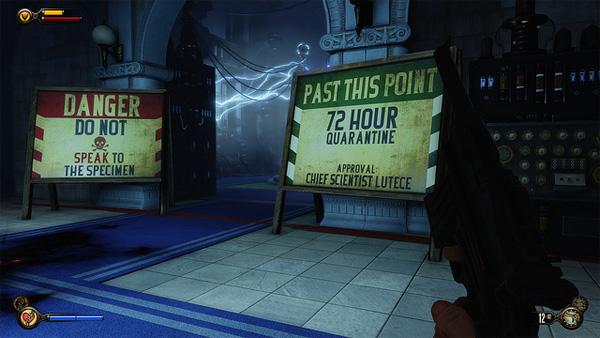
…
…
…
NO, REALLY, DO NOT CONTINUE READING IF YOU HAVE NOT PLAYED THROUGH TO THE END OF BioShock Infinite. This is your final warning!
Near the end of BioShock Infinite, it is revealed that there are an infinite number of universes, all of which are made up of constants and variables. Elizabeth explains, “There’s always a lighthouse, there’s always a man, there’s always a city.” At this point in my playthrough, it became very clear to me that BioShock Infinite is essentially the same story as the first two BioShock games, with the differences between them being the variables. One bit of evidence to support this theory is the fact that Booker is able to operate the Rapture Bathysphere, which has been locked down to only respond to Andrew Ryan or his kin. This implies that Booker is an alternate version of Jack.

But these three things — the lighthouse, the man, and the city — are hardly the only parallels we can draw between the games. There are many more, some of which are constant between all three games, and others which show up in at least one of the Rapture-universe stories and BioShock Infinite. A few of these are pretty obvious as you play through BioShock Infinite, though without the context revealed by the game’s ending, they seem more like homages to the original game.
Partly to keep it all straight in my own head and partly for the benefit of my fellow gamers, I decided to make a list of all the parallels I could think of!
The Kit

As our hero (Jack in BioShock; Booker DeWitt in BioShock Infinite) nears his initial destination, he opens a box containing items relating to his quest: mysterious instructions and a gun.
The Lighthouse

BioShock and BioShock Infinite both start with our hero entering a strange city by way of a lighthouse. As we find out in BioShock Infinite, there are an infinite number of lighthouses, each a portal to a different dimension. Interestingly, in BioShock, Jack travels to his lighthouse, which leads to an underwater city, by air; in BioShock Infinite, Booker travels to his lighthouse, which leads to a city in the air, by water.
The View
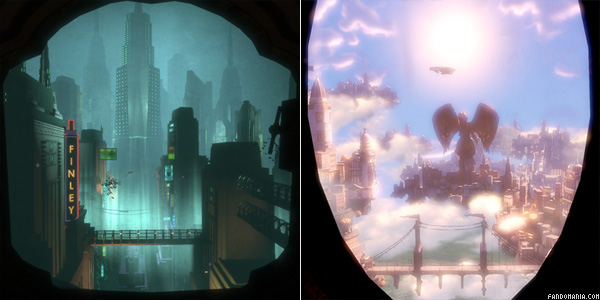
From the lighthouse, the man must take a shuttle of sorts into the actual city: a Bathysphere in BioShock and a rocket-like capsule in BioShock Infinite. Our first view of each city is through the window of this shuttle.
The City

Rapture and Columbia are both isolated cities in impossible locations, founded with the intention of escaping the ills of society (to which each city’s residents see themselves as vastly superior).
The Entrance
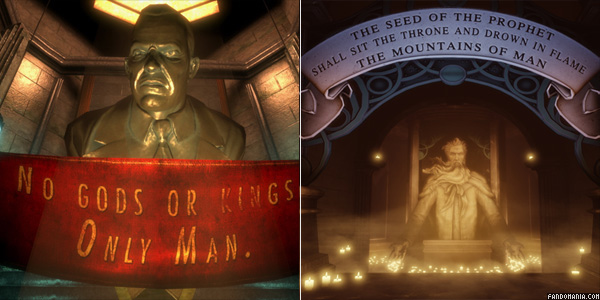
As the Man exits his shuttle, he enters the city through a sort of “welcome area” featuring huge statues of each city’s founder and proclamations about the city’s purpose. Visually, these areas bear striking resemblance to one another, but the words on each banner contrast about as sharply as they possibly could.
The Man
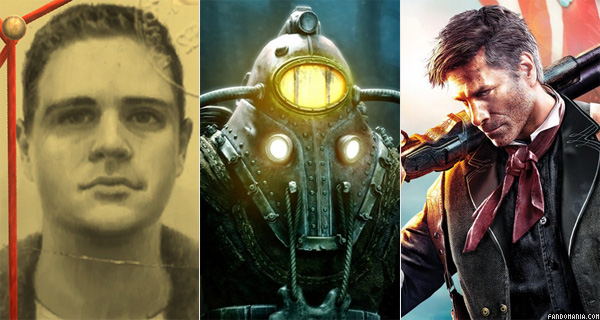
In BioShock, we play as Jack; in BioShock 2, Subject Delta; and in BioShock Infinite, Booker DeWitt. Each of these is “The Man” referred to by Elizabeth. Because Subject Delta is already in Rapture when we begin the game, his story does not include the preceding few parallels, but for most of the rest of the game his role is consistent with Jack and Booker’s.
The Girl
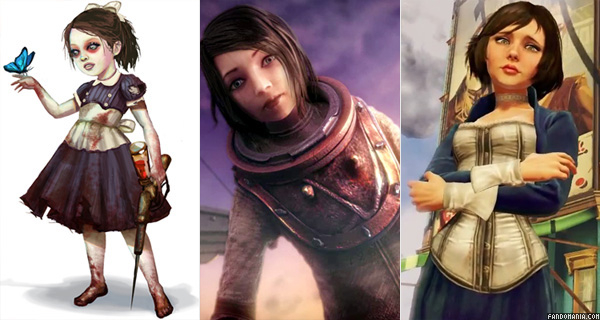
There is always a girl who is imprisoned in some way, yet who wields special powers. In BioShock and BioShock 2, the Little Sisters vary in appearance, but they are frequently shown (as in the concept art above) to have dark hair and blue eyes. Eleanor Lamb, in BioShock 2, and Elizabeth, in BioShock Infinite, share this coloring. There is also a very clear similarity between Elizabeth’s outfit and that of the Little Sisters — and, of course, there’s the fact that Eleanor’s last name is Lamb and Elizabeth is known in Columbia as The Lamb.
The Megalomaniac
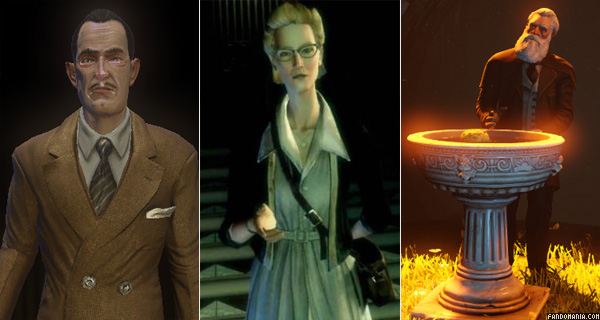
The hero’s main rival (at least ostensibly) in each game is an egomaniacal, corrupt leader. In BioShock, it’s Andrew Ryan, the founder of Rapture. In BioShock 2, it’s Sofia Lamb, a psychologist who brainwashes her patients into cult worship. And in BioShock Infinite, it’s Zachary Comstock, the founder of Columbia. Ryan, an atheist, eschews religion, but both Lamb and Comstock whip their followers into a religious fervor, painting themselves as spiritual figures in addition to political or economic ones. Another interesting parallel between these three is that each is the parent of one of our main protagonists. Andrew Ryan is Jack’s father, Sofia Lamb is Eleanor’s mother, and Comstock, while not technically Elizabeth’s father, is a version of him, and claims her as his heir.
The Protector
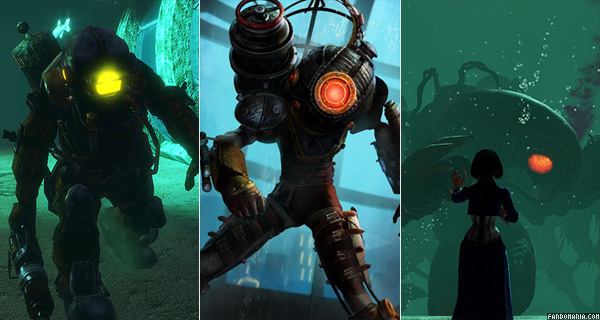
There is always a Protector assigned to the Girl. In BioShock, the Big Daddies keep scavengers from harming the Little Sisters. They also do this in BioShock 2, but additionally there are Big Sisters who fill this role. Technically, the Big Sister is not a main protector for our BioShock 2 Girl, Eleanor, except that she is formerly a Little Sister and the Big Sisters are agents of Sofia Lamb. Eleanor actually becomes a Big Sister herself later in the game, at which point she essentially becomes her own protector. And in BioShock Infinite, Songbird is tasked with keeping Elizabeth imprisoned in her tower. Typically, as Columbia is a city in the sky, he is seen flying around, but I couldn’t resist using this image of his death in Rapture since it provides such clear symmetry with the other games.
The Mark

Jack bears a chain tattoo on each of his wrists, Subject Delta’s glove is emblazoned with the Greek letter after which he is named, and Booker has branded his own hand with his daughter’s initials.
The Power
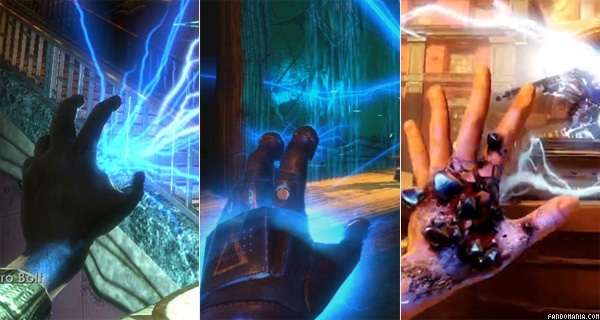
In Rapture, Plasmids are injected as a means of genetic enhancement, giving the user special powers like Electro Bolt, seen above. These powers are fueled by substance called EVE, which must be replenished in order to use the powers. In Columbia, instead of injection, people can drink Vigors which give them powers very similar to those of Plasmids — some almost identical, like the above-pictured Shock Jockey. Instead of EVE, Vigors are powered by salts, which can be ingested either through liquid found in vials or simply by eating salty foods. Both EVE hypos and salts vials are blue in color (to be fair, probably more a creative choice by the game developers than a story parallel, since both Plasmids and Vigors are forms of “magic” which, in many games, is fueled by typically blue mana).
The Mega-Corp

The cornerstone of Rapture is its free-market capitalist economy, so it’s unsurprising that several businesses expanded to have their hands in many different industries. There are actually two that figure heavily into BioShock: Ryan Industries and Fontaine Futuristics. It’s Fontaine Futuristics, however, which funded the development of ADAM and the creation of Little Sisters and Big Daddies. BioShock 2 also features products made by Ryan Industries and Fontaine Futuristics, but introduces Sinclair Solutions, commissioned by Ryan to provide Plasmids and Gene Tonics to ordinary citizens as a method of product testing. Columbia does not promote the same capitalist values as Rapture (50% of all business profits must be sent directly to Comstock) and really has only one major industrial company, Fink Mfg. They produce and/or distribute practically everything in Columbia, from Vigors to vending machines to turrets.
The Revolutionary

In both Rapture and Columbia, there is a huge class divide, with the aforementioned corporations making use of poorer citizens as both workers and guinea pigs to increase their bottom line. Naturally, this breeds resentment and tension grows. In BioShock, the semi-mythical figure of Atlas leads the people to revolt against Ryan, and in BioShock Infinite, Daisy Fitzroy leads her Vox Populi group to do the same. In both cases, the Revolutionary appears to offer a better alternative than the status quo, but unfortunately it’s revealed to be an illusion (intentionally in Atlas’s — actually Fontaine’s — case, since his goal all along is upheaval; for Fitzroy, it seems more that she gives into allowing herself and her followers to be driven by vengeance rather than justice).
The Catchphrase
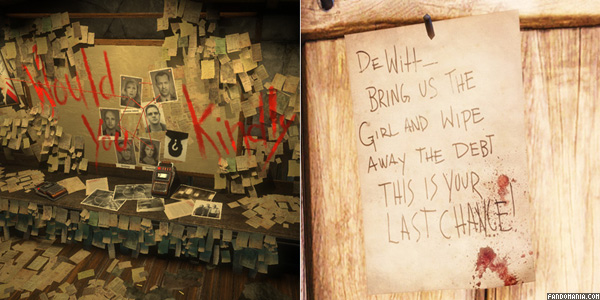
Both BioShock and BioShock Infinite have a catchphrase which repeats throughout the game. In BioShock, “Would You Kindly?” is a subliminal trigger phrase used to control Jack, and the player probably doesn’t even realize how many times it’s repeated until the plot twist toward the end of the game. In BioShock Infinite, the phrase “Bring us the girl and wipe away the debt” is supposedly Booker’s assignment from his client, and he repeats it to himself many times as he tries to accomplish his goal for his own selfish reasons. Much like “Would You Kindly”, though, it’s revealed to have a hidden meaning, as the phrase was actually used originally 20 years earlier, when Booker was offered a chance to sell his baby, Anna, to Comstock in exchange for paying off Booker’s gambling debts. Of course, it’s the same girl, but the context is completely different, and we see how Booker’s mind actually used the phrase to trick himself into making new memories when he was brought through the tear — much as Jack’s mind is manipulated by Fontaine with his catchphrase.
The End

Assuming your choices led you to the “good” endings of BioShock and BioShock 2 (choices which, themselves, imply branching realities), each of these games ends with a group of the Girls surrounding a main character. In BioShock, if Jack frees the Little Sisters, they become his family on the surface and he watches them live happy lives. In BioShock 2, Subject Delta has a similar choice to save the Little Sisters. If he does, Eleanor leads them to the surface and, presumably, they also have a happy ending. In BioShock Infinite, Booker is confronted with many different versions of Elizabeth. In both comparison and contrast to the Little Sisters, Elizabeth’s fate is both happy and sad. She is erased, but baby Anna is allowed the opportunity to live out her life without interference from any other dimension.
Another parallel here is that The Man dies during each of these scenes. Jack seems to fare the best, as he lives to be an old man. Delta only just makes it to the surface before his injuries and broken bond with Eleanor do him in. And Booker is drowned by the Elizabeths to prevent him from becoming Comstock. The latter two are able to live on in a way, though — Eleanor extracts ADAM from Delta, storing his consciousness within herself, and Booker can live out his life normally in other universes, if not this one.
Along the same lines as the plane/boat comparison from the first entry in this article, BioShock and BioShock 2 end with the main character breaking the water’s surface to return to the air, while BioShock Infinite ends with Booker being submerged in water.
So — taking all this into consideration, does this mean that BioShock and BioShock 2 actually take place in two separate versions of Rapture?
Did I miss any parallels? Share any connections or comparisons you noticed in the comments below!



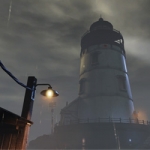



Nice article, Celeste! I had really studied the ending, but even I missed a few of these parallels, including the catchphrase and the mark.
I think you cover them all, but one additional point (and you may disagree with this being a parallel) is how death is handled in each game: in Infinite either Elizabeth saves your life or, as it is implied, the Lutece’s do, by (I think?) transitioning you to a parallel universe in which you don’t die. Vita chambers work differently, but, in the first two games, as well, it is impossible for the protagonist to actually die and fail his quest. I’m not entirely sure what this says, exactly, or if it has anything to do with the story (perhaps it is simply a design choice in BioShock 1 and 2, that manifested into a story-driven one out of necessity), but it still is an interesting parallel.
Thanks, Ryan! I think death can be interpreted a number of ways in Infinite. My feeling on it is that when Elizabeth saves you, it’s through regular medical attention. I’m not sure about the times when she’s not around and you exit Booker’s apartment to respawn.
I’ve seen others suggest (and I concur) that our playthrough of the game is experiment 123 of the Luteces to get Booker — *a* Booker — to successfully rescue Elizabeth. When Booker first enters Columbia, the Luteces have him flip a coin, and there are 122 tally marks on the “Heads” side of Robert’s sandwich board. So, presumably, those are all different versions of Booker who come through, and it’s always heads because the timeline doesn’t start branching until after that point. The code to the lighthouse is also 1-2-2. So, given all this, I don’t know if I think the Luteces are actually intervening to rescue Booker. Obviously they do intervene in some ways, like giving Booker a shield, and I think they base these interventions on other attempts which have failed — like the reality where he becomes a Vox martyr. But then if they aren’t directly switching you to a different universe where you don’t die, I don’t know how to explain being back in Booker’s apartment when you die without Elizabeth around.
In any case, I can see how Vita-Chambers could be a parallel, since they basically re-create a version of the person from right before they died. Good thinking!
Brilliant. Thanks for the point about the tally marks, etc., which, again, I had not considered (that colors the game a bit differently for me).
Yeah, I have not yet found an adequate explanation online for how death — that is, your death when Elizabeth is not around — is handled (perhaps others are not as interested in this as I am), but my thinking (and, trust that I do, also, concur with the experiment 123 notion) that it is / was the Luteces intervening in the event of the player’s death is borne out of a tool-tip which appears when (or, I guess, if) you first fall off Columbia (not a deliberate story decision, but on the part of the player character yourself), which says something to the effect that *someone* has saved your life. Based on subsequent in-game events and story reveals, I assumed that this savior was the Luteces, switching you to a universe where you do not die. Of course, your explanation now muddles that theory a bit, and so I, too, am no longer sure how to explain why you find yourself back in Booker’s apartment upon dying, or why there is no penalty for falling off of Columbia, even though the game hints at one.
Er, “… even though the game hints at [an explanation].” That sentence was vague.
Ah, I fell off the edge a few times and never noticed the thing about the savior — interesting. I suppose you could say maybe the Lutece field bounces you back or something, haha. But that’s just a guess and not really supported by anything in the game.
Or maybe the Luteces do save him somehow, and those don’t count as failed versions in their experiment. Maybe the 122 failures were irreversible things other than Booker’s death which would prevent everything from going according to plan?
I believe that in infinite’s ending when they drown Booker that is it with the other Anna/Elizabeths disappearing, since she was never born booker died before he could meet the woman who would bear his child. And another thing as far plot goes from what I gather from the game Comstock couldn’t bear any children. Which is why he needed an heir which is why he employed lutece after finding out her contacting with an alternate dimension lutece to find Booker/Comstock and to see if he has a child. Comstock jumped thru the tear and met up with the male version lutece and met booker and saw how he was living and gave him an offer. Since Comstock is her father just from another reality she was technically by blood the rightful heir to his throne.
So yeah Believe me I went thru this story back and forth and read up listened to all fo the recorded dialog.
Thanks for your response, john! I’m not sure how “our” Booker managed to take the place of the one that would become Comstock at the baptism, but I believe that the Bookers who came from the choice not to go through with the baptism would survive and have a chance to meet Anna’s mother (hence the after-credits scene). None of the Annas will become Elizabeth, though, since Comstock would never be there to interfere.
First, I would like to say great article. I would have never thought of these variables.
But there are more constants.
One being the messages scattered throughout the cities. In Bioshock and Bioshock 2 its by short wave radio. In Bioshock: Infinite its by voxophone.
Another being the bodies shutting down. In Bioshock its the trigger phrase Code Yellow. In Bioshock 2 its the effects of the bond being broken. In Bioshock: Infinite its Booker remembering his death in that tear.
And the lastly is the ruler always raises the city against the protagonist. In Bioshock Andrew Ryan puts splicers in your way. In Bioshock 2 Sofia Lamb puts splicers and Big Sisters in the way of the “parasite.” In Bioshock: Infinite there are cops, firemen, handymen, and many other opponents put in the way of “the false shepherd” by Father Zachary Hale Comstock.
@MercOfValor: Thanks so much for your response — those are all excellent additions to the list!
Thank you but your the one to be thanked for this article because I know I never would have thought about it like this even though I did wonder what the “constants” could be so now every time I play a game in the Bioshock series I look for the “constants and variables”
*you’re